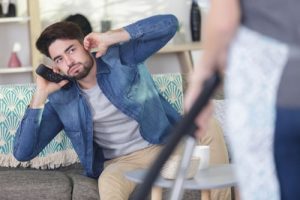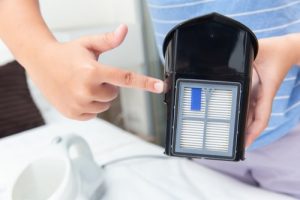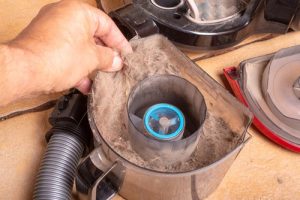Cleaning can be a difficult and annoying chore. Understandably, most people prefer to use vacuum cleaners – one of the most common and reliable cleaning gadgets. If you’re thinking of purchasing a good one, consider Shark vacuums. Its working reputation is often the reason why it’s the favorite choice of some users.
You may already have one with some problems in its use. Don’t panic! At some point, it’s normal for any machinery we use daily to have these issues. Since the vacuum cleaner does most of our dirt cleaning jobs, having problems is nothing strange.
 There’s no worse feeling than having to part with your cleaning tool and spending to get another one. Luckily, there are quick fixes to your Shark vacuum cleaner.
There’s no worse feeling than having to part with your cleaning tool and spending to get another one. Luckily, there are quick fixes to your Shark vacuum cleaner.
When you start to notice problems with the way your vacuum cleaner operates or difficulties in picking up dirt, you need to troubleshoot your Shark vacuum to prevent damages beyond repair quickly. The problem might be an inner function or in the setup, or sometimes in particular significant parts. Regardless of what it is, they are all fixable.
Here in this article, we will discuss the solutions to the most faced problems of the Shark vacuum cleaner and how to avoid them. Most faced problem list:
- Suction Noise
- Suction power
- Motor not working
- Overheating
- Charging problems
So, let’s start to dive deeper!
Shark Suction Noise
 Suction noise in Shark vacuum cleaners is not normal. It could be as a result of dirt in the filter or the brush roll. Here’s a quick fix to the suction noise problem.
Suction noise in Shark vacuum cleaners is not normal. It could be as a result of dirt in the filter or the brush roll. Here’s a quick fix to the suction noise problem.
- Unplug your vacuum
- Remove the dirt and debris from the dust cup
- Uninstall the filters and clean them with water
- Observe the vacuum hose’s airflow, the end of the handle, and also the front of the wand
- Ensure there’s no debris or dirt on the brush roll.
You should also check all the parts and accessories of the shark vacuum to ensure nothing is broken. Check the hose, brush, and other components to see no physical part is damaged and needs repairs or replacements.
After following these processes you see dirt as the cause of the suction noise. You have to do some cleaning to ensure the suction of your shark vacuum is restored.
How to clean the filter of the Shark Vacuum
 Cleaning the filters of your vacuum is required as part of its regular maintenances.
Cleaning the filters of your vacuum is required as part of its regular maintenances.
The first step to do this is to remove the bin. There are two points of interest to keep in mind while cleaning the filter: inside the container where you have a little metal grate and a second filter.
For the metal grate, check for dirt or debris. Use a scrubby pad or an old toothbrush to clean the dirt. Wash the second filter with warm water until the water runs clear. You need to let it dry for up to 24 hours before reinstalling it. There’s also a little cotton filter that can reduce the suction power when it’s dirty. Clean it properly if you find dirt on it.
The HEPA filters are not washable, so you can use a little air compressor to clean the dirt. When the dirt is more a bit extra, you should replace the filter. HEPA filter replacement is not so expensive to get.
How to clean the brush roll
You have to clean the dirty brush roll to reduce the suction noise. For the different models of shark vacuum cleaners, there are several options for cleaning the brush rolls. Some models are made such that taking off the brush roll plates are easy, while others are a little technical.
If yours has three plastic knobs, you can easily unlock them and take the belt off. While taking the straps off, you may face difficulties like a string or hair obstructing the removal.
Use scissors or any easy-to-cut tool to pull the dirt off the brush bar. If the obstruction is heavy, carefully use a razor blade and make sure you avoid cutting the bristle of the brush bar.
With issues like hair or strings or anything obstructing the airflow, your Shark vacuum cleaner would be having problems with the suctions. The problem even gets more significant when the dirt hampers your vacuum suction power, so it’s important to clean the entire brush bar.
Shark vacuum loses suction
When your shark vacuum loses suction, it stops picking up dirt when used. Some reasons why your vacuum can lose suction includes a full dust cup, blockage in the vacuum, dirty filters, damaged hose, bad motor.
 Full dust cup
Full dust cup
When your dust cup is too full, vacuumed dirt would have no space to stay. The way to fix this is by removing the dust cup and emptying it. After unpacking the dust cap, if your vacuum still does not pick up dirt, read further for other options to solve the issue with the loss of suction.
Blockage in the vacuum
Another reason why your vacuum is losing suction could be an obstruction in the airway. Something blocking the airway can cause hindrances to dirt and debris being sucked up by the vacuum.
The two places to check for blockages are on the dust cup air duct and the intake opening behind the brush roll. For blockages in the dust cup air duct, place the vacuum upright and remove the dust cup. Then disconnect the super stretch hose to see if the air duct behind the dust cup.
The second place to check is for clogs near the roller brush. Lay the vacuum down and check for clogs in the opening behind the brush roll. If you find dirt there, clean the space with scissors and, with care, remove every debris.
Unclean filters
If you haven’t cleaned your filters in a while, it could be why there is a loss of suction in your shark vacuum. To get this done, remove the dust cup for access to the top of the motor base and remove the two filters.
With lukewarm water, rinse the filters until the water runs clear. When the filters are thoroughly dried, put them back into the vacuum. If this remains a problem, replacing the filter could be a possible solution.
Damaged hose
 A damaged or deteriorating hose can be the reason behind the weak suction. Most shark vacuums have two hoses you need to inspect. It has one short hose between the main vacuum head and the base and the second between the handle and the wand.
A damaged or deteriorating hose can be the reason behind the weak suction. Most shark vacuums have two hoses you need to inspect. It has one short hose between the main vacuum head and the base and the second between the handle and the wand.
When these hoses get old, they can crack and peel over time. Sometimes, the splits are not so noticeable. Microcracks in the hose could cause loss of suction. It’s a good thing they are relatively inexpensive and available in typical retail stores.
Bad motor
If none of the mentioned reasons for your vacuum is losing suction, then the motor will go bad. Most times, the cost of a new engine is almost the same as the vacuum itself. Since it’s not so easy to replace, a new vacuum may be what you need now.
Shark vacuum motor not working
 There are several things you can do when your motor stops working. You can take it apart to see if it has a fixable fault, replace the entire unit, or try to reset the motor.
There are several things you can do when your motor stops working. You can take it apart to see if it has a fixable fault, replace the entire unit, or try to reset the motor.
The rotary broom action motor might work while the actual vacuum suction motor doesn’t work even when the unit is plugged. While handling your hose, moving the switch to the first position is supposed to turn the engine on. Do that, and switch it to the second position. This time, it’s supposed to turn off the motor and the bristles such that it becomes difficult to move the bristle part with the actual motor on the vacuum cleaner.
You can proceed further to digging into the vacuum cleaner by opening it up to check for the reason behind the motor not working. However, if you still have a warranty on your appliance, you shouldn’t have to take the unit apart.
Usually, the product’s manual comes with suggestions on tackling issues with the motor not working. It could be as a result of clogged filters or stuff like that. Without turning on the switch, lift off the canister by taking off the two sides. Check to see that there’s no dirt dust. If there is, clean it off.
At the bottom of the unit, there are screws. However, before attempting to unscrew it, ensure the appliance is unplugged. Push the red tab and pull the bottom part off the vacuum to access all the screws.
After removing the screws, take the piece apart and watch the spring and the other components to see what happens. Also, check the motor’s fuse to ensure the engine’s problem is not a blown fuse. Another move you can make is replacing the motor.
How to replace the motor
With care, disconnect the black wire on one side and the white wire on the other side. The black wire is always on the same side as the adapter, while the white wire is directly on the opposite side.
Flip the other side’s black bracket to prevent the motor from turning on and running in the opposite direction. Get the right polarity and connect both the black and white wires to the replacement motor.
When the fault is not a burnt motor but from something being jammed in the engine or a switch problem resetting the motor should solve the problem
How to reset the Shark vacuum’s motor
The motor of shark vacuums sometimes could require a reset to get it working again. With a step by step detailed instruction, you can complete this task
- Power off the shark vacuum cleaner from the button
- Unplug the vacuum cleaner from the mains
- Check the filters and hose for clogs. If you find any, replace the filter or wash it with clean water and remove the clogs from the hose.
- Wait for the vacuum cleaner to cool completely, then plug it back into the mains.
If after this your motor still is not working, it’s likely something more severe. Cases like this may be safer if you contact Shark customer service to help you find a better solution.
Shark vacuum overheating
For suction from the shark vacuum, there needs to be a flow of air. In case the airflow gets blocked, the motor protective thermostat equips the vacuum steam. This should cause the thermostat to turn off the Shark when it overheats automatically.
However, when you notice your vacuum cleaner is overheating, the first thing to do is to unplug it from the mains and give it at least 45 minutes to cool. Most times overheating is caused by one of the following issues.
- Clogged hose
- Clogged filter
- Full or dusty canister
- Hair of strings wrapped around the brush bar
- Electrical issues
Let’s discuss these problems and causes of an overheating shark vacuum and how you can solve them.
Check the dust cup
After switching off the vacuum when it overheats, your first move is to check the dust cup if it’s full or blocked. A mass of dust bunny could be hiding in the hoses and restricting the airflow. It causes the unit to overheat. Clean out the dirt or blockage in the dust cup.
Clogged filter
Allow your vacuum cleaner to cool for about 45 minutes and check all the filters of your Shark. Clogged filters restrict the airflow, and due to complete drainage, the appliance doesn’t suck well. It can result in overheating. Check the filters and remove any clog you see.
Electrical issues
Electrical problems are another cause of Shark vacuum overheating. It could be as a result of frayed wire or a more severe issue. It pays you to check it out.
If you see that you have a wiring problem, replace it. However, the motor is a delicate part of the Shark, and a problem with it can cause more damage to your vacuum. If part of the shark vacuum motor is rubbing on another element or other components, it gets hot.
It can happen that your pet’s hair is locking down the beater bar or wrapped around the brushes. Inspect the brushes for hair or strings and if there is any, remove them. To stop the pet air from wrapping around the vacuum brushes, regularly brush your pets and, if possible, do it away from home. Regardless, you cannot totally prevent accumulating hairs as long as you have pets. Well, this is one reason why you have the shark vacuum cleaner in the first place.
If you have tried these and your shark vacuum cleaner still overheats, then maybe it’s time you hire a professional’s help or take advantage of your warranty.
Shark vacuum not charging
There’s almost nothing as frustrating as your vacuum not charging. When you notice this, ensure the charger and stand are correctly plugged into a powered outlet.
Some things to do when your Shark isn’t charging include:
- Turn the vacuum off:
Some shark models will only charge when it’s set off. Ensure the appliance is off, and attempt to charge.
- Test the charging stand:
If the charge is done directly via the charging stand, the stand can be the problem’s source. Test your charging stand by plugging the vacuum using the charger alone.
- Replace the charger:
The charger itself may also stop working and need a replacement. If your connecting cable or charger stand is damaged, it will hinder your vacuum from charging. In this case, consider replacing the charger or the charger stand, or even both.
- Check for loose connection:
Verify that your charging adapter is correctly plugged into the charging base and the outlet. Be sure that the device fits snug into the charging base without excess space to move.
- Clean obstructed charging contacts:
The contacts may have too much dust on them and need to be clean. If the charge contact is covered with too much dirt, it cannot charge. Clean the metal contact around both the back of the motorized brush and the charging base using a dry fiber cloth. DO NOT USE DAMP CLOTHES FOR ANY REASON! Water droplets left behind from damp clothes can damage the electronic parts and contribute to the bad connection.
Reasons why the shark vacuum is still not charging
Asides from the above, there are other reasons why your Shark would stop charging. There’s no need to fret since fixing them is pretty easy and cannot take up too much of your day.
Faulty Outlet: It’s possible that our outlet not working is the problem. You can test to see if the power source is the problem by plugging in a mobile phone or a lamp into the same outlet.
Also, plug the vacuum charger into a different outlet. If the device charges without issues, then the problem is with the initial outlet you used. But if it doesn’t, then there’s another reason for your vacuum cleaner not charging.
Dead battery: Just like a mobile phone’s battery, rechargeable batteries can eventually lose the ability to hold a charge. This happens most time to older vacuums. A typical Shark vacuum battery should charge for about 16 hours.
If you charge your Shark for this amount of time and it doesn’t work for more than a few minutes, then you need to replace the battery. However, if you just bought your vacuum, a dead battery might not be the issue you’re having.
Any of these malfunctions can be covered by a warranty. After you troubleshoot, you can contact the company to see if a warranty covers your appliance.
Conclusion
Shark vacuum cleaners have positive reviews in different marketplaces. The lightweight structure, optimal suction power, and simple maneuverability are some of the reasons why lots of customers seem to stay loyal to this product.
Shark vacuums are great cleaning partners and can clean both pet hairs and dust in seconds. Also, they perform excellently on several surfaces, including laminated carpets and tiles. The features and functions offered by this device justify its dominance in marketplaces.
However, your shark vacuum can need repairs, and with the solutions and fixing guides to these faults, we have tried to help you in this regard. The repairs and fixes listed here are relatively simple and can be done at home. But it’s important to note that if you don’t feel confident enough to carry out any of these processes, there’s no shame in calling the shark customer service line or a professional for help.

